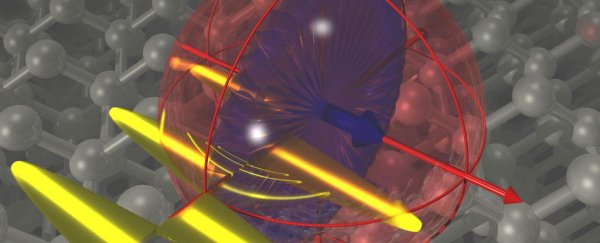Scientists in Australia have developed a quantum bit that's 10 times more stable than existing technologies, and the new record could vastly expand the kinds of calculations quantum computers can perform.
Whereas conventional computers process information recorded in binary bits that either take a 0 or 1 value, quantum computers use quantum bits – also called qubits – that can occupy 0, 1, or a superposition that can be both at the same time.
The new qubit developed by researchers from the University of New South Wales (UNSW) is called a "dressed" quantum bit, because the team combined the single atom at its heart with an electromagnetic field.
In doing so, they've been able to keep quantum bits in superposition – existing in two states simultaneously – for 10 times longer than previous efforts, and that extra time could make quantum computing calculations a whole lot more stable.
"We have created a new quantum bit where the spin of a single electron is merged together with a strong electromagnetic field," says researcher Arne Laucht.
"This quantum bit is more versatile and more long-lived than the electron alone, and will allow us to build more reliable quantum computers."
While quantum computers are often hyped as being insanely more powerful than the computers we use today – with processing speeds hundreds of millions of times faster – one of the barriers in developing them is the superposition itself.
It's the superposition that makes quantum computers so tantalising, because the ability for information to occupy two states at the same time is what gives the technology almost unimaginable scope in calculations.
But that strength is also quantum computing's weakness, as the superposition is extremely fragile and short-lived, making it difficult for researchers to realise the awesome potential of quantum computing.
"The greatest hurdle in using quantum objects for computing is to preserve their delicate superpositions long enough to allow us to perform useful calculations," says one of the team, Andrea Morello.
But by subjecting a single atom in silicon to a very strong, continuously oscillating electromagnetic field at microwave frequencies, the researchers were able to extend the preservation of the superposition for 10 times longer than a standard qubit.
The extended lifespan of the dressed qubit is still vanishingly short from a human perspective – just 2.4 milliseconds – but that would be long enough to enable significantly more operations in a quantum computer.
In addition to expanding the superposition window, the electromagnetic field also gives scientists greater ability to manipulate the qubit.
"This new 'dressed qubit' can be controlled in a variety of ways that would be impractical with an 'undressed qubit'," says Morello. "For example, it can be controlled by simply modulating the frequency of the microwave field, just like in an FM radio."
"In some sense, this is why the dressed qubit is more immune to noise," he adds. "[T]he quantum information is controlled by the frequency, which is rock-solid, whereas the amplitude can be more easily affected by external noise."
Quantum computers themselves are probably still some way off, though. While Google has developed a simulation it says is a quantum computer, not everybody is convinced their effort is as powerful as an actual quantum computer would be.
But when quantum computers do arrive, the researchers say their dressed qubit technique will work with the kinds of silicon chips we use in today's digital devices.
"This result gives us a new tool to create a powerful and reliable quantum processor in silicon," says Laucht, "using standard fabrication methods as used for everyday computers."
You can find out more about the research in the video below:
The findings are reported in Nature Nanotechnology.
UNSW Engineering is a sponsor of ScienceAlert. Find out more about how they're solving the world's problems.
